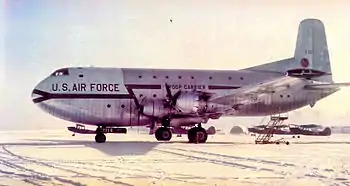1951 Atlantic C-124 disappearance
The 1951 Atlantic C-124 disappearance involved a Douglas C-124 Globemaster II of the 2nd Strategic Support Squadron, Strategic Air Command, which ditched on the late afternoon of 23 March 1951, after an explosion in the cargo and ensuing fire forced the pilots to ditch the aircraft at 50 degrees 22 minutes North, 22 degrees 20 minutes West, in the Atlantic Ocean several hundred nautical miles West Southwest of Ireland, as recorded in the logbook of the USCGC Cutter Casco. The ditching and subsequent evacuation were successful, but when Casco arrived at the ditching position, the aircraft and its occupants had vanished.
 A C-124A similar to the aircraft that disappeared | |
| Accident | |
|---|---|
| Date | March 23, 1951 |
| Summary | Controlled ditching due to in-flight fire; unexplained disappearance |
| Site | Atlantic Ocean, 725 km (453.1 miles) west of Shannon, Ireland[1] |
| Aircraft | |
| Aircraft type | Douglas C-124A Globemaster II |
| Operator | United States Air Force |
| Registration | 49-0244 |
| Flight origin | Walker Air Force Base, Roswell, New Mexico, U.S.[2] |
| Stopover | Limestone Air Force Base, Limestone, Maine, U.S. |
| Destination | RAF Station Mildenhall, Suffolk, England, U.K. |
| Passengers | 44 |
| Crew | 9 |
| Fatalities | 53 |
| Survivors | 0 |
Flight
The transport was on a military flight from Walker Air Force Base in Roswell, New Mexico, to RAF Mildenhall in Suffolk, England, with a stopover at Limestone Air Force Base in Limestone, Maine. It was commanded by Major Robert S. Bell, of the Second Strategic Support Squadron (similar to the 1950 Douglas C-54D disappearance in that respect). At 1300 hours, 23 March 1951, the aircraft radioed "Mayday" to Weather Ship USCGC Casco, reporting a fire in the cargo crates and giving their position as 51 degrees 30 Minutes North, 27 degrees 05 minutes West, according to the logbook of USCGC Casco.[3] Unable to extinguish the fire, Major Bell made the decision to ditch while there was still daylight. The exact ditching position of 50 degrees 22 minutes North 22 degrees 20 minutes West was radioed to Casco. The aircraft landed safely and intact. All hands then donned life preservers and climbed into inflatable 5-man rafts equipped with numerous survival supplies, including food, water, signal flares, cold-weather gear, and "Gibson Girl" hand crank emergency radios.[1][2]
A Boeing B-50 Superfortress, from the 509th Bomb Wing Detachment, was en route from RAF Lakenheath with the intention of joining up with the stricken aircraft and escorting it to the nearest landing site. When the B-50 arrived at the ditching position the crew spotted the survivors in rafts and flares.[3] The location was reported and the B-50 reached its minimum fuel required for safe landing and had to return to base. When Casco arrived at the ditching point on 24 March, the men had disappeared. Casco was later joined by British planes, weather ships, submarine, several warships, including the USS Coral Sea, which arrived at the crash site over 19 hours later, on Sunday, 25 March. The aircraft, along with its passengers and crew, were gone. All that was found was some charred plywood and a briefcase.[3] The survivors' bodies were never found. Overall, the fate of the crashed C-124 and its 53 occupants remains undetermined.[2]
Investigation
A copy of the Air Force official report into the crash was provided to the Shreveport Times in 2011 via a Freedom of Information Act request. According to the accident report, "The aircraft was evidently, more or less, intact when it hit. This is indicated by the small number of pieces recovered, as well as the fact that two inflated aircraft tires carried as part of the cargo were never found. Also, the debris found was burned by fuel fire from fuel in the wing fuel cells, which indicates that the wing fuel cells were still attached to the fuselage. There is no conclusive proof that anything unusual happened before the aircraft struck the water, not that it struck the water out of control. There is evidence that a fire occurred on top of the water after the aircraft hit."[4] Included in the report are over a dozen pages of debris analysis by the airplane's manufacturer, Douglas Aircraft Company.[4]
Possible Soviet involvement
Brig. Gen. Paul Thomas Cullen, vice commander of 2nd Air Force and commander of 7th Air Division, and other senior officers were passengers on the plane. Soviet vessels were active in the area. This fact, combined with the possibility of sabotage, the strategic value of the passengers, the potential distressed note recovered, and the knowledge that the evacuation from the airplane into safety rafts was a success has led some to speculate on potential Soviet involvement.[4]
Burials
In 2012, more than 50 years after the disappearance of all personnel on board the plane, two men from the crash were granted graves at the Arlington National Cemetery.[5][6][7]
References
- "Accident description". Aviation Safety Network. Retrieved 14 October 2013.
- Andrew, John (26 March 2011). "Plane's 1951 disappearance still a mystery". Air Force Times. Retrieved 14 October 2013.
- "Last Flight, The Missing Airmen, March 1951". Walker Aviation Museum. Retrieved 21 October 2013.
- "Mystery flight survivors seek answers". Shreveport Times. 6 July 2015. Retrieved 17 June 2020.
- "Jon Mark Beilue: Man gets military funeral 61 years after death". Amarillo Globe News. 5 May 2012. Retrieved 14 October 2013.
- Rafferty, Lawrence (1 April 2012). "MK 269". JONATHAN TURLEY. Retrieved 14 October 2013.
- Synett, Lawerence (20 April 2012). "Air Force captain who disappeared on mission in 1951 gets a marker at Arlington National Cemetery". Chicago Tribune. Retrieved 14 October 2013.
External links
- "Globemaster Lost" the news report as it appeared in Flight